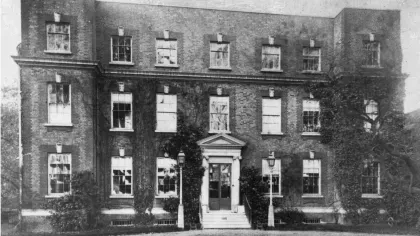21 October 2016
Poisonous plants, pumpkins and the paranormal
As Halloween draws closer and the shops are filled with dancing skeletons and miniature pumpkins, Archives Graduate Trainee, Francesca Mackenzie delves into the Library, Art and Archives Collections to find material relevant to the upcoming festivities.

Strange beasts and poisonous plants in the Herbals
One of the oldest collections of books in the library at Kew are the Herbal manuscripts, taking up several shelves in the Library store room. These are essentially medieval guidebooks to plants and their properties, as well as featuring animals. The printed illustrations feature a plethora of creatures and menacing plants. Diagrams include griffins and were-animals to the more bizarre monk-fish (quite literally a fish with the shaved head of a monk) and a weeping tree.
Some of the more interesting images in Ortus Sanitatus include illustrations of the male and female mandrake. Mandrakes are a poisonous plant with hallucinogenic properties. Due to their twisted and bulbous roots they have captured the human imagination for centuries. One of the more obvious popular culture references being the screaming plants in J K Rowling’s Harry Potter books. The roots are said to look human, as the following illustrations demonstrate.
Ghosts in the correspondence
When on expeditions, Plant Hunters did not only face physical hazards, some encountered problems of a more paranormal nature. One such case is that of Robert Jamie who writes to Kew’s Director, Joseph Hooker from Singapore in 1875. His particular problem is that it would be difficult to gain access to the mountains to collect a certain species of plant as ‘the Malays are terrified to go on the mountain as they say it has- Ghosts’. As a sceptic he speculates that this may be due to the tigers who are rather more numerous than the ghosts.
Closer to home, the Kew Herbarium is said to have its own ghost, that of George Bentham. Bentham was a prolific English botanist working at the same time as Darwin, who collaborated with Joseph Hooker. In a letter, found inserted within B.D. Jackson’s biography of Bentham, Kew Research Associate Robert Sealy mentions the potential for Bentham’s ghost to be haunting the library, however he takes a sceptical approach to the ghost’s existence.
‘The room which used to be known as the “top central library” or “travels room”, is said to be the one where Bentham worked at Kew. The room contains a fireplace, which, until it was closed up during building work some years ago, was open and had a fire fender and splendid fire-irons. No doubt a fire burned there in cold weather in Bentham’s time, which was, of course, before central heating was installed. However it was never used in later years and just remained an open fireplace. Now the fire-irons would occasionally move slightly and produce a quiet rattling sound - and this was attributed to Bentham’s ghost. Who started the story I do not know, I just picked it up when I came to Kew.’
A Halloween recipe from the Archives
Emmanuel Bonavia was a botanist working in the late 19th and early 20th century. During his time in India he would frequently write back to directors at Kew sending specimens and seed samples. His letters are filled with exciting uses for the different plants he collected. One particular letter states the particulars of how to cook pumpkin, a topic of such importance that it takes up two pages!
'The best way to cook pumpkin is to remove skin and seeds- cut it in cubes an inch each way and steam it very very gently in its own juice, with butter, chopped onion, pepper and salt. If too dry add a little stock or gravy or even water. [Pumpkin...] is delicious cooked in this way- otherwise pumpkin is very tasteless.'
There are many more wonderful and amazing stories waiting to be discovered in Kew’s Library, Art and Archives Collections. To find out more, please visit the Library Reading Room and speak to a member of the Library, Art and Archive team or keep an eye out on the Kew website for upcoming tours. Hopefully, when you make your visit, you won’t encounter Bentham’s ghost!
- Francesca Mackenzie -
Archives Graduate Trainee

